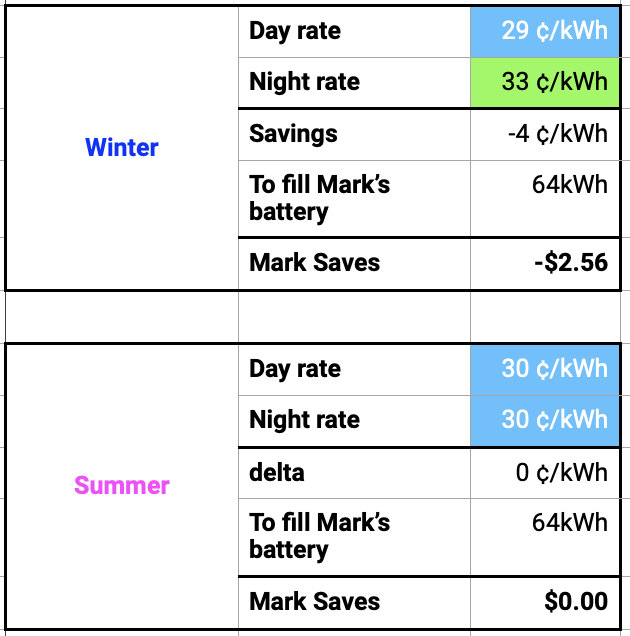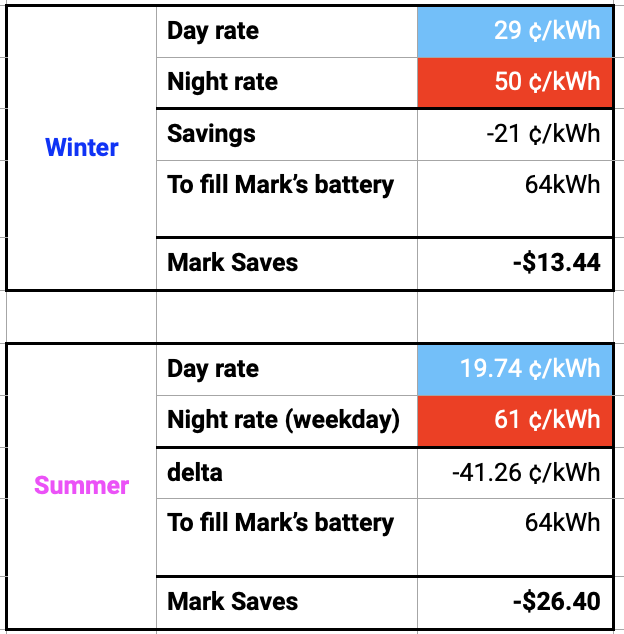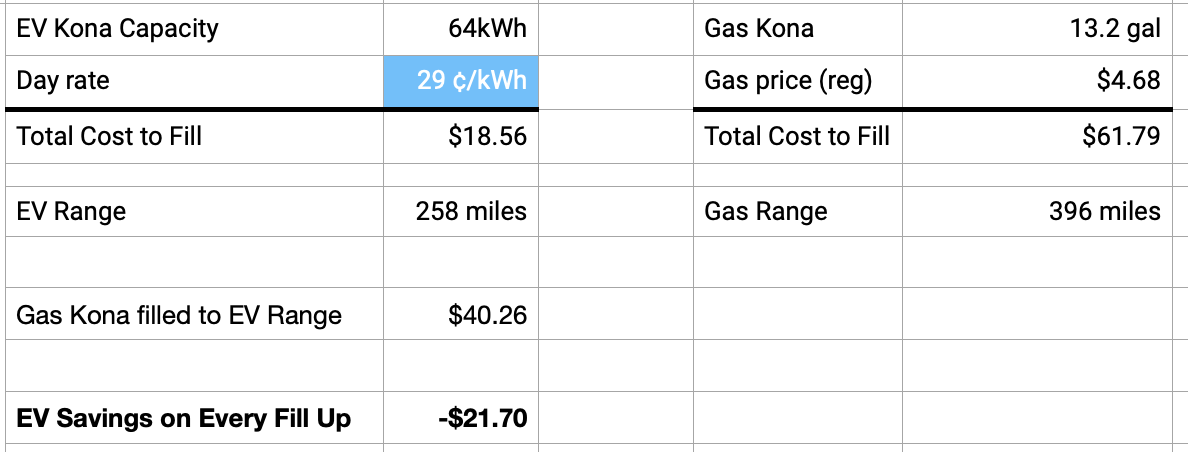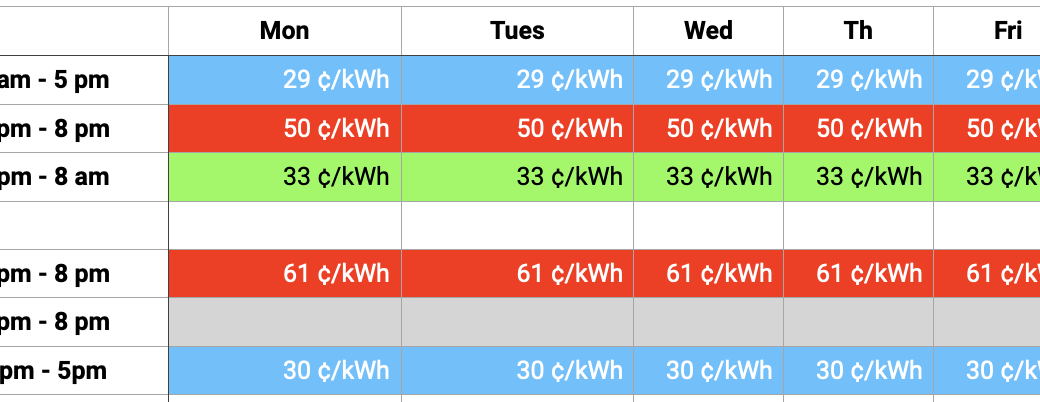This week’s Dumb Question comes from my long-time friend Mark. I’ve known Mark since I was in high school so we go way back. He got solar for his house right around the same time as us and got an electric vehicle. He asked me this question.
Hope y’all are doing well. Had a solar/EV car question. Given how Edison works, is it better to charge my car at night (when rates are low, but no solar generation) or during the daytime (when rates are up, and yet max solar generation)?
You would think there would be an easy and obvious answer to this question. Steve and I are both engineers with advanced degrees, and we’ve been studying the facts behind the question, and arguing our respective interpretations of the subject for at least the last six months. It’s surprisingly complicated, and every time we think we understand it, the next time we look at it our interpretations have changed.
When Mark asked this question, we decided to write it all down and that I would write an article about it so we can refer back to it every time we get confused.
Net Energy Metering
The first thing to understand is something called Net Energy Metering, or NEM, sometimes called simply Net Metering. Net Energy Metering is a billing mechanism that allows people who generate renewable energy to push energy into the grid when the sun is out or the wind is blowing, and then use energy from the grid when they’re not generating (Source: Wikipedia). The way NEM is applied varies from state to state, and country to country, if it’s used at all. Everything I’m going to describe here only applies if you have NEM where you live.
I can only talk about the way NEM works in California, but the logic should be useful if you can find the rules for your locale. California is currently under NEM 2.0, with a proposal being worked for NEM 3.0, but don’t get me started on that because it’s a dumpster fire. If you’d like to read all about the current version of NEM in California, I’ve included a link to the California Public Utilities Commission at www.cpuc.ca.gov/…
While I am going to use California-specific information, I think that you could walk through the same logic and math if you live in another state or country that does use Net Energy Metering.
Yearly True-Up
The first step is to determine how you get credit for the energy you generate. In California, our energy generation and usage are recorded every month, and at the end of 12 months, there’s a true-up.
If you generate more energy than you consume over the 12-month period, then the electric company actually pays you for the excess you generate, albeit at the market rate, which is currently running around 2-3¢ per kWh. It’s chump change but it’s something.
The first and most simplistic answer to Mark’s question is:
Answer #1 – If Mark generates more than he uses, it doesn’t matter what time he charges his car because he never pays for it.
Now let’s assume that Mark uses more energy over a 12-month period than he generates via his solar panels. The excess energy he uses will be charged out in a much more complicated methodology. It’s ludicrously complicated and that’s why Steve and I have had so much fun debating the topic.
Time of Use
When you go onto NEM when you get your renewable energy up and running, you are required (in California) to go onto a Time of Use (TOU) billing plan.
The concept behind Time of Use billing is to encourage the customer to move their energy usage from when the grid is under high demand to when it’s under lower demand. The best way to get customers to change their behavior is to give them financial incentives to do what you want them to do. If you know it costs more to run your dishwasher right after dinner than it does during the night, you’re more likely to wait until the demand on the grid is lower.
The grid is under the most demand in the evenings when most people come home from work, e.g. 5-8 pm, so the Time of Use rates are much higher during that time period.
I think this design is fantastic and logical. But like many things, I was personally responsible for in my own work, the desire to keep optimizing turns what’s a good idea into a far too complex algorithm for normal humans to understand.
Southern California Edison’s Time of Use Billing
Like Steve and me, Mark gets his electricity from Southern California Edison. Their version of Time of Use breaks the day up into three spans of time called Super Off Peak, Mid Peak, and Off Peak with three different rates. But that’s just for the winter. In the summer, they only use two timespans called On Peak, and Off Peak, except on weekends and holidays, when the On Peak pricing time changes to be called Mid Peak and it’s a different rate.
Do you see why this is so nuts and why Mark didn’t know the answer to his question? But don’t lose hope, we can figure this out.
The reason all of these rates are important is that if at the end of the year, you use more energy than you produce, the electric company tracks every kWh of energy you use by the time of day you use it throughout the year. This is recorded every month on your bill. When they do the 12-month true-up, if you’ve exceeded the energy you generated, they use this Time of Use billing to figure out how much to bill you.
I’m not going to read out all of the numbers because that would be super boring. I created a Numbers spreadsheet with conditional highlighting to show you what it looks like.

Armed with this vast array of options, let’s be thankful Mark only asked for two time frames: charging at night when rates are low, or charging during the daytime when rates are high but he’s generating energy. Mark asked the question in winter:
- In the middle of the night, Mark’s energy costs 33 ¢/kWh
- While he’s generating energy, Mark’s energy actually costs less at 29 ¢/kWh
When Mark asked his question, I also thought energy was less expensive in the middle of the night, but we were both wrong. We now know another version of the answer to Mark’s question. If Mark consumes more than he generates, it’s better for him to charge during the day when he’s generating energy.
I didn’t want to stop here though. If it costs less to charge while generating solar energy, how much does it actually save?

Mark drives a Hyundai Kona, which has a 64kWh Battery. The difference in cost between the off peak and mid peak rates is 4 ¢/kWh. To fill his battery from zero to 100% (which of course you’d never do) it would save him $2.56 if he charged during the day rather than in the middle of the night.
But let’s put this in perspective. I wouldn’t throw $2.56 out the window, but that’s only a little more than half the cost of one gallon of regular gasoline in California right now ($4.681)! That really highlights how inexpensive it is to charge an electric vehicle at home vs. buying gas for an ICE car, doesn’t it?
We have our second answer to Mark’s question:
Answer #2 – If Mark consumes more than he generates, during the winter it actually saves him money to charge his EV during the day, but it may not be enough to stress out about.
Perhaps Mark is also curious though about how the math works out in the summer. It turns out that in a comical stroke of genius, the committee that designed Southern California Edison’s Time of Use billing decided to make the rate from 8 pm all the way through the next day to 5pm the same rate at 30 ¢/kWh. This gives us our third answer:
Answer #3 – If Mark consumes more than he generates, during the summer it doesn’t matter whether he charges during the day or late at night, it’s the exact same cost.
Avoid Evening Hours

There is a time of day Mark probably definitely does not want to charge his car, and that’s between 5 and 8 pm. During the winter, that 5-8 pm rate is 72% more than the daytime rate, and during the summer the 5-8 pm rate sky rockets to more than double the daytime rate. This was, perhaps, the biggest shock of this study for me.
In the winter, Mark would spend over $13 more to charge between 8-5 pm, and in the summer it would cost him a whopping $26 more.
Answer #4 – Whatever you do, don’t charge your car between 5-8 pm (especially in the summer) if you consume more power than you generate.
How Much Does Mark Save Driving an EV?
I know this is off topic from Mark’s original question, but when I compared the extra cost of charging during the night vs the day to the price of a gallon of gas, it got me wondering whether I could calculate from all of this data how much Mark saves by driving an EV instead of an internal combustion engine (ICE) car.
We’re in luck because Mark just happens to have purchased a rare car – the Hyundai Kona comes in both an EV version and a gas version. In an article from Motortrend, I was able to find the range of the two vehicles. I also determined that the gas version uses Regular unleaded fuel, which is the cheapest gas possible.
While the EV Kona has a respectable 258-mile range on a 64 kWh battery, the gas version has a range of 396 miles on a 13.2-gallon tank. Using the current regular gas price in the state of California at $4.68/gallon according to AAA, filling the gas car will cost $62. But we have to prorate that total cost down to the smaller 258 miles of range.
When the math is said and done, Mark is saving $22 every time he fills his car with electrons instead of dead dinosaurs.

Bottom Line
The bottom line is that it’s better for Mark to charge his car during the day when he’s generating solar energy than at any other time of day. In the best case, if he’s generating more energy than he’s consuming it doesn’t cost him anything no matter when he charges. If he consumes more than he generates, then he definitely wants to avoid charging his car between 5-8 pm!
I hope this process of analysis can help others to run their own math. I’m sure your rates are different, your times of use are different, you may not have time of use at all, and don’t even get me started on how to size a battery to go with your solar.


Nice article! A couple of thoughts/comments:
You wrote, “In the winter, Mark would spend over $13 more to charge between 8-5 pm, and in the summer it would cost him a whopping $26 more.” I think you meant to say 5-8pm in this sentence.
Also, related to that section, you show dollars it would cost to fully charge Mark’s car in the expensive 5-8pm window; however you neglect to acknowledge that no EV could be fully charged in 3 hours on a home charger. Most home chargers are on 40A circuits, with a 32A max delivery current. At 220V, that’s right around 7kW of charging power. A full charge would take 64/7 > 9 hours. Even going from 10% to 80% (a more common charging scenario) it would still take >5.5 hours.
Furthermore, what’s most likely is Mark arrives home at 5:30 or 6pm, and plugs in, so only 2-ish hours would be at that high rate. Way less than half his charging time & dollars.
Another thing you didn’t model in this post, but maybe you and Steve discussed, is that Mark has a solar system! You only modeled the cost of power from the grid. If he charges during the day, a good chunk of that energy comes directly from the sun (maybe all/most of it?) and only a tiny bit comes from the grid. If his solar system generates a max of 6kW (just for example) during peak summer sun, then he’s only paying for 1/7th of the energy going into his car (assuming a 7kW wall charger, and no other household loads).
Anyway, I’m also a Mechanical Engineer, and I enjoyed your post! It was a good explanation of NEM and TOU billing.
Thank you for your post. We are new to the EV world, but not new to Solar. I purposely designed the system to support an EV charge during the average sun production cycle. We peak generation at 10kw during the summer months and half, or less, during the winter months. Prior to the EV we always on the credit side during the true-up date.
We are with SDG&E and the super off peak, off peak and peak hours are different from your math. With the new Jan 2023 rate increase, the supper off peak rate is .354/kw, off peak rate is .432/kw and peak hour rate is .496/kw for the Winter NEM TOU DR-SES schedule.
Using your logic, it appears the best time to charge would be the supper off peak hours (midnight -6am) and use the max solar generation during the day, as a battery, to offset the night time charging. This would be especially true during the Summer rate schedule which is much higher spiking the peak hour rates to .80/kw, off peak rates to .465/kw and supper off peak rates to .362/kw.
This is all assuming a NEM 1:1 buy/sell ratio
Our new EV takes approx 4hours to charge from 60% to 90% at 40amps 240VAC. I could bump the input to 48amps for a shorter charge cycle, but it seems less efficient.
The only other variable that comes to light is the fact, during the high solar generation of the summer months, it may be more effective to charge during the day off peak hours vice the supper off peak hours. Of course this depends of the use of A/C during the summer months as well.
Our goal was to be at a zero balance at the true-up time if possible. Time will tell the story.
Regards, JohnF
Thanks! This is exactly the question I was looking for an answer too!
Note: SoCal Edison has 3 TOU plans.
1) TOU-D-4-9PM
2) TOU-D-5-8PM
3) TOU-D-PRIME
You used TOU-D-5-8PM in your example
TOU-D-PRIME is what I have (A rate for an electric vehicle or plug-in hybrid owners and lessees, customers with a residential battery, or customers with an electric heat pump system for water or space heating. This rate has a fixed daily basic charge which allows for lower Super Off-Peak and Off-Peak rates. This is ideal for customers who use clean energy technologies and can shift that usage to lower-cost times.
https://www.sce.com/sites/default/files/inline-files/TOU-D-PRIME_Fact_Sheet_0320_WCAG.pdf
TOU-D-PRIME:
Winter Weekdays(8am-4pm Super Off Peak $0.22, 4pm-9pm Mid-Peak $0.57, 9pm-8am Off-Peak $0.22)
Winter Weekends(8am-4pm Super Off Peak $0.22, 4pm-9pm Mid-Peak $0.57, 9pm-8am Off-Peak $0.22)
Summer Weekdays(8am-4pm Super Off Peak $0.24, 4pm-9pm Mid-Peak $0.62, 9pm-8am Off-Peak $0.24)
Summer Weekends(8am-4pm Super Off Peak $0.24, 4pm-9pm Mid-Peak $0.37, 9pm-8am Off-Peak $0.24)
With TOU-D-PRIME since BOTH “middle of the night” (9pm-8am) and Daylight “generating energy” (8am-4pm) are the SAME $0.22/kWh Winter or $0.24 Summer it seems to me it doesn’t matter when I charge my EV as long as I don’t charge during the Mid-Peak 4 hours between 4pm-9pm ($0.57/kWh Winter or $0.62/kWh Summer).
MikeK – thanks for all the info. After we got batteries installed we did switch to the plan where you pay a super high rate during 4-9 and a super low rate during the rest of the day. I presume all battery systems can do this – with the Tesla Powerwalls, we’re able to tell the system to use battery during 4-9 and solar/grid the rest of the time. We were already neutral, generating enough power to compensate for usage, but it’s nice now to have it even more green. If there’s ever a storm watch, the Tesla app will keep the batteries at 100%, and not use it from 4-9. Pretty smart!
You may want to fix this — probably meant 5-8pm?
“In the winter, Mark would spend over $13 more to charge between 8-5 pm, and in the summer it would cost him a whopping $26 more.”
Thanks Rajiv! I can’t believe after all this time nobody had pointed out that I had the numbers flipped!
Since I wrote this, we’ve added whole-home batteries, which allowed us to have a Time of Use that’s $.21/kWh during the day, and $.54/kWh between 4-9. No matter how long it takes the car to charge, I’ll never schedule it for between 4-9!